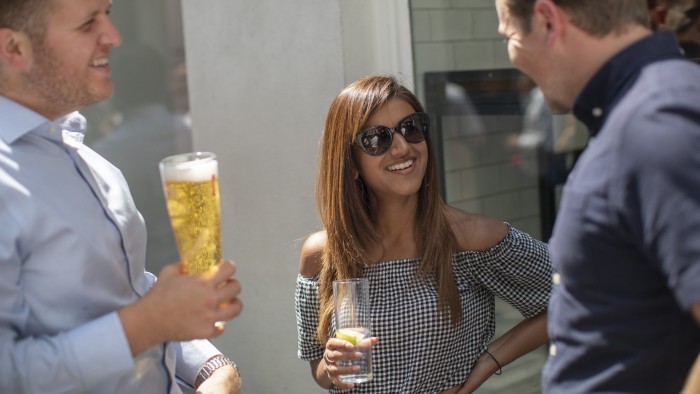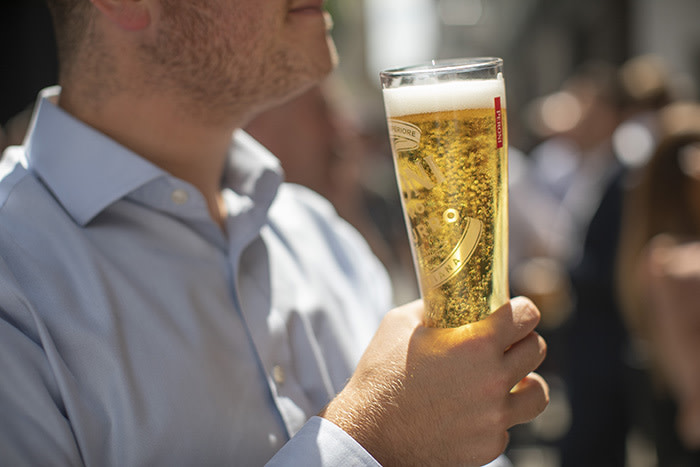Why work events are becoming a sober experience

Simply sign up to the Work & Careers myFT Digest -- delivered directly to your inbox.
Julia Phillips, a corporate events organiser, has noticed a change in clients’ requests for their pre-dinner activities: alcohol-free drinks.
Previously, a typical team-building session would involve a series of alcohol-based challenges. In a twist on the TV series The Great British Bake Off, for example, colleagues make a signature cocktail and compete in a technical round.
But while clients still like drinks-based events, they increasingly want to offer employees the opportunity to shake a mocktail too. “We [might] do something where the cocktail we’re creating is very lime heavy — [with the option] to include vodka,” says Ms Phillips, managing director at events agency Crescendo. Such requests have risen from about 10 per cent to 50 per cent of clients over the past 18 months, she adds.
In the past, employees would express a reason for not drinking, she says — for example, a drive at the end of a train commute, religious grounds or pregnancy. But younger workers tend not to bother. “Millennials just want to have something where they don’t drink — they don’t give a reason. It’s a generational difference.”
While there is no desire to ditch the cocktail shaker altogether, employees want more options. “People want to learn,” says Ms Phillips, “they like the experience of, say, learning about the history of rum.” There are parallels between this trend and flexitarians — people who are largely vegetarian but eat the odd piece of meat. “People will mix it up,” she adds.
Drinks companies have seized on such tastes — variously described as “sober curious” or “mindful drinkers”. Diageo, for example, has invested in Seedlip, a British company that makes non-alcoholic distilled drinks, while Anheuser-Busch InBev and Heineken have developed their range of no- and low-alcohol beers in recent years.
Greater health awareness is one driver, though other factors include changes in leisure activities, such as gaming. Social media, which can become a public forum to shame drunken mishaps, is another factor.
The #MeToo movement has also forced many companies to review their alcohol policies. Earlier this year, Lloyd's of London, the insurance market, announced that it would bar people who have been drinking or are under the influence of drugs from the premises. It followed sexual harassment complaints and a previous ban on daytime drinking.
But corporate entertainment — after-work drinks, networking events, award ceremonies and even incentives — are still dominated by alcohol. One public relations executive observes that it is impossible to get the “old guard to realise that giving out a bottle of cheap wine as a reward for good work needed not to be the norm any longer — that it was really ‘othering’ folks who didn’t drink.”
A focus on alcohol is not confined to large legacy organisations. The bro-culture of tech companies has also been criticised. In 2014, Kara Sowles, who works at Puppet Labs, a tech company in the US, wrote: “Without a culture of drinking, would the start-up world still be the hip bastion of partying that sets it apart from its corporate twin?”
The alcohol culture means people feel pressured to drink, says Stephen Pereira, a psychiatrist whose private clients are largely City workers. “Given the choice, many people might not drink but there’s an expectation that if others are drinking they should too. People don’t want to feel left out.”
Simon Eastwood, a corporate trainer and coach, agrees. Work events are “so alcohol-centric that it often makes non-drinkers feel they are not part of the ‘club’,” he says. Some 35 per cent of employees do not want to drink at corporate events, but of those, 15.8 per cent do anyway, according to research from Niznik Behavioural Health, a US organisation that treats alcoholics.
On a sunny lunchtime outside a pub in the City of London, three twenty-something recruiters, each with an alcoholic drink in hand, say they would not go to a work function and not drink. Their employer organises inclusive non-alcohol activities, such as a sports day, but then “we go to the pub”, says one.
Lauren Booker, a consultant at Alcohol Change UK, says this feeling of being excluded tends to affect older professionals more. “This is an ingrained pattern as you go further up the management ladder. Younger people are less inclined to drink.”
Post-work drinks can be challenging for young Muslims who do not drink, says Shelina Janmohamed author of Generation M: Young Muslims Changing the World. “They want to hang out with senior people.” She does believe things are slowly changing: “It’s not a wild thing to say you don’t want to go for a drink.”

Laura Willoughby, co-founder of Club Soda, a mindful drinking movement, says that corporate events are a hard nut to crack. “Caterers have to fulfil a healthy catering policy, offering salad as well as burgers at lunchtimes. They don’t extend this to the evening . . . Corporate entertaining is behind,” she says.
Last year, in a blog post, Ms Booker described attending a swanky corporate reception with vast quantities of champagne and craft beers: there was apple juice and orange juice served with green and white straws for non-drinkers.
It is not just the small choice of sugary alcohol-free drinks that is old-fashioned, Ms Willoughby says, but also the way they are typically served. Waiters top up glasses with alcohol, but non-drinkers are expected to serve themselves.
A large part of the problem is cost, says Ms Phillips. “A lot of hotels [venues for corporate events] are driven by alcohol — the margins are profitable. The mark-up on non-alcohol drinks is less.”
There is also a resource problem: budgets are tight and responsibility for events is often given to an overworked admin assistant, says Ms Sowles. “Managers can invest in their team health by recognising work-event planning as essential labour, setting aside enough budget to provide options that work for everyone.”
Things are starting to change, she adds. “Teams are asking — what activities can we do together that don’t exclude many of our colleagues? The answers, fortunately, are getting richer each year.”
Stuart Elkington, founder of Dry Drinker, which sells no- and low-alcohol drinks, says he has seen a 20 per cent increase in orders from companies in the past 18 months. This is partly driven by “innovative products” he says.
Fugitive Motel in east London has an extensive non-alcoholic drinks menu. David Burgess, co-founder, says he is receiving interest from City-based companies to host events at the venue. “I’m 35, but blown away by 21-year-olds whose alcohol consumption is down. That will drive change in the corporate world.”
Drinking is on the decline
- More than half (58 per cent) of consumers are drinking more no- and low-alcohol drinks this year than in 2018, according to a report by Diageo.
- In the US, 54 per cent of the population chose to abstain from alcohol, driven largely by 21-34 year olds, according to market researchers Nielsen CGA’s On Premise User Survey 2018.
- In the UK, the proportion of non-drinkers among 16-24-year-olds rose from 18 per cent in 2005 to 29 per cent in 2015, according to a study published in the BMC Public Health journal. The research found that non-drinking “is becoming more mainstream among young people”.
- The proportion of teetotallers in the 25-44 age category rose from 15.5 per cent in 2005 to 20.6 per cent in 2017, according to the most recent Office for National Statistics research on ages and drinking. This is a much higher percentage of teetotallers compared with 45-64 year-olds whose numbers only increased slightly — from 15.5 per cent to 16.4 per cent — in the same period.
Comments